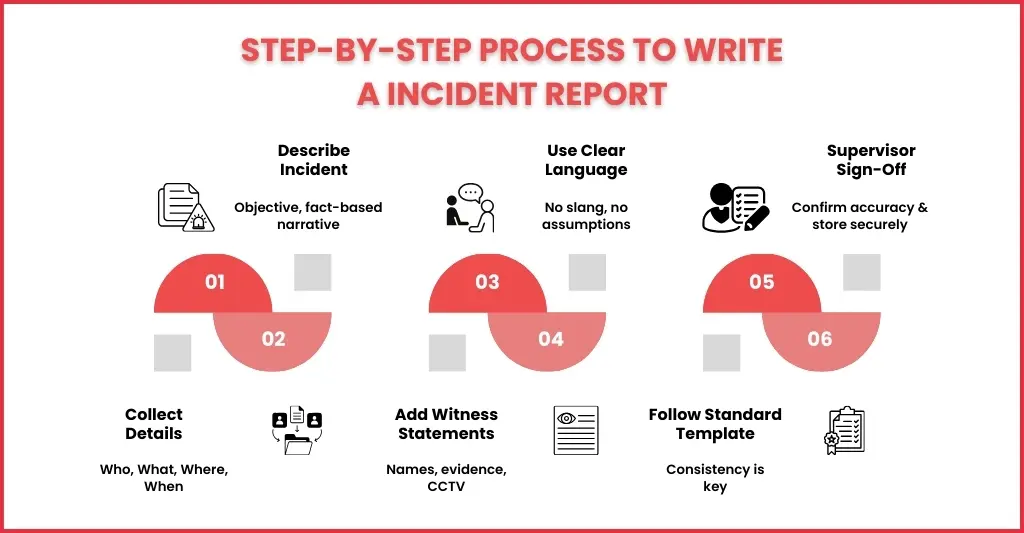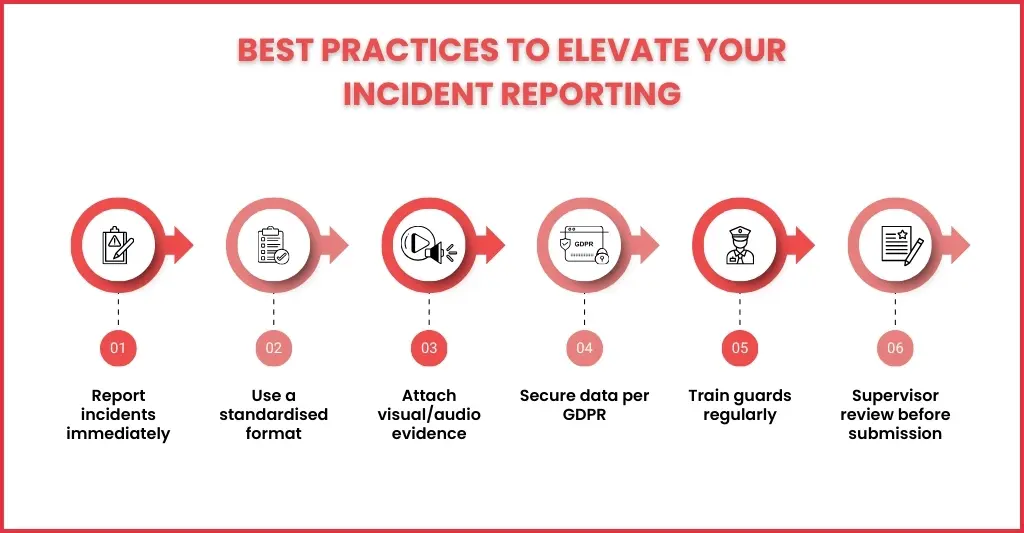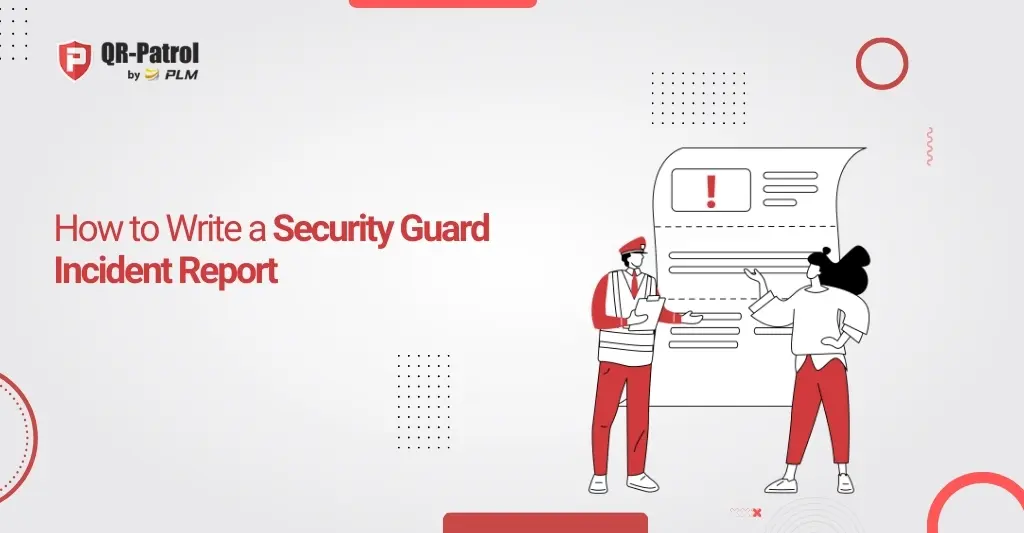Your security guards encounter multiple incidents, both small and large, daily in the areas they provide security. While the priority will be defusing the situation, an incident report must be made for the sake of accountability.
Under the supervision of a security guard, an incident report must be filed for all incidents that occur during the shift. What your security guard writes will affect your response and that of the premises owner and help in identifying cracks in crisis-dealing procedures.
Given the significant importance and dependence placed on the incident report, it must be created thoroughly. These requirements have motivated us to develop this guide on the incident report. Here, you will find the importance, key aspects, preparation guidelines, and best practices to adopt.
Let’s learn more about the incident report.
UK Legal and Regulatory Framework:
- The Security Industry Authority (SIA) regulates security personnel, including incident reporting requirements.
- British Security Industry Association (BSIA) best practice guidelines should be followed to ensure compliance.
- Adhering to these standards supports legality and enhances credibility within UK security operations.
What is a Security Guard Incident Report?
An incident report contains all the incidents that have taken place during the shift of a security guard. These incidents could include disturbances, fights, accidents, or suspicious activity. The report will contain details such as the incident’s date, description of the event, and names of those involved.
These reports are then sent to superiors, such as managers or clients, so that they can analyse the incident and take corrective actions. It is important to note that an incident report is used to document unusual occurrences. That includes fights, theft, property damage, medical emergencies, and any situation. Such a written record is required for legal, safety, or client reasons.
Incident reporting in the UK is critical for insurance claim support and compliance with the Health and Safety at Work Act. Accurate reports validate damages and injuries, facilitating smooth insurance processes and regulatory reviews.
Why Writing an Incident Report Correctly Matter to Security Teams?
Incident reports cannot be taken lightly; hence, they must be written with utmost care. We say this because when something goes wrong, the first thing that will be reviewed is the incident report.
Here’s why these reports matter to security teams and how they help keep operations on track:
Legal Liability
An accurate and easy-to-understand report will always protect your guards during an investigation by law enforcement agencies, lawsuits, or insurance claims.
Maintaining Visibility
Incident reports help managers and supervisors to understand the incidents that have taken place and decide on further actions.
Creating Confidence
The owners of the premises guarded by your security guards will always demand accountability. The best way to do that is by showing them the incident report. A good report will demonstrate to your clients the seriousness with which you are documenting incidents and the actions taken in response.
Officer Accountability
The report will show which guard responded to the incident, what they did to handle it, and when they did it. Such accountability to the security guard’s duties fills in the gaps when something is lacking.
Key Elements of a Security Incident Report
A security incident report is a formal document that is used to report, analyse, and record any security incident taking place at the protected site. Your guards must prepare reports in a thorough and easy-to-understand manner, which is vital for both legal and compliance purposes, as well as for enhancing the overall effectiveness of security operations.
Ensure that these key elements are part of the security incident report.
Accuracy
It is essential to track the exact moment the incident occurred, the more precise the better. Clearly describe the incident that took place, which includes the area within the premises and other relevant location details. Categorise the incident so that it is appropriately handled and reported to the right people.
Describe the Incident
Describe the incident as it happened and avoid assumptions. It must cover the sequence of actions leading up to, during, and after the incident. List down the people involved in the incident, including security guards, witnesses, or suspects. Note down names and job titles. Also, note down the steps taken to manage the situation, such as alerting authorities, securing an area, evacuating individuals, or following company protocols.
Statements of Witness
Record the incident information from eyewitnesses, including their names, job titles, and contact details. Look for CCTV footage, photos, and audio recordings; this will provide solid evidence and back the statements of the witnesses.
Impact Assessment
Record the damages to the property, equipment or physical premises that have taken place due to the incident, along with the location and damage cost. Also, record any injuries that may have occurred to employees, security personnel, visitors, or suspects, along with the medical assistance provided.
Indeed, a mass injury incident will impact the operations of the premises. Record the disruptions that occurred and their causes, as this information can be important for insurance claims or internal reviews.
Action Taken
Summarise the actions taken to resolve the incident, including calling emergency services. It also includes showing how your security guards communicated the incident to their superiors and whether emergency procedures were followed correctly.
Preventive Measures
Analyse the incident based on the data to determine whether it resulted from a security breach, human error, inadequate protocols, or another factor. Suggest improvements in SOPs that will prevent such incidents and follow-up actions.
Supporting Documentation
Is there any more visual evidence to support your report, especially if there are any injuries or damages? Even a photograph will be helpful. Obtain digital entries that support the events leading up to the incident, such as alarm system reports. If law enforcement or emergency services were involved, attach official r eports or citations.
Report Sign-Off and Distribution
Please make sure the report is reviewed and signed by the supervisor and the relevant parties; this will confirm its accuracy. Also, indicate who will receive a copy of the report (e.g., site managers, clients, local authorities, insurers). Ensure that you store the report in a secure storage site in digital format and in compliance with data protection regulations.
UK Data Security and Privacy Compliance Requirements
UK data security requirements under the Data Protection Act 2018 require encrypted storage and controlled access to all digital evidence, including CCTV and voice recordings, to protect privacy and comply with legal standards.
Step-by-Step Guide to Writing a Security Guard Incident Report

A clear incident report will help in describing what happened. To do that, you will need to follow the steps mentioned below.
Step 1: Collect the Basic Details
Begin by noting the basics, including who was involved, what happened, where it occurred, and when. Such details will come first, along with full names, times, and accurate locations to reduce the possibility of confusion.
Step 2: Describe What Happened Clearly
Write down clearly what had happened and focus on what was seen, heard, and can be validated. There should be no assumptions or personal opinions which will create confusion and damage the credibility of your security firm.
Step 3: Add the Statement of the Witness
Write down the list of people who were present at the location where the incident took place, along with evidence such as surveillance footage, photos, or any damage you saw on-site. This will give credibility to your report.
Step 4: Use Clear Language
Use clear-cut and straightforward language, avoiding long sentences, slang, or jargon that may be difficult to understand. The report must be easy to read and understand for even a layperson.
Step 5: Follow a Standardised Format
Select a template based on which the report will be prepared. By keeping the report structure consistent, you will help your clients find the information quickly and assist supervisors in ensuring that all procedures are followed.
Standardised Incident Report Templates for UK Security Firms
UK firms should adopt incident report templates aligned with guidance from the SIA and BSIA that include:
- Date/time/location details
- Names and roles of all involved parties
- Incident descriptions and timeline
- Witness statements and evidence lists
- Actions taken and emergency responses
- Supervisor sign-offs
This standardisation supports audit-readiness and legal compliance.
Common Mistakes to Avoid in Incident Reports
However, we cannot discount the fact that even an experienced security guard can commit mistakes, which can reduce the report’s credibility. It would be best to avoid those mistakes to keep the reports reliable and helpful during reviews.
Unclear Language: Kindly avoid writing assuming language like “the person looked weird”. Specify the exact behaviour like its talks, actions, and so on.
Missing Timelines: Establish a timeline for report creation; any delays would complicate verification of events and their timing.
Emotional Tone or Opinions: Train your security guards to avoid making any emotional or biased comments. Hence, avoid phrases like “he was probably drunk”.
Skipping Important Context: Don’t forget to mention who was notified or what actions were taken, as this can make a report seem incomplete. Always include follow-up steps, even if nothing major happened.
Best Practices for Security Guard Incident Reporting

The importance of a security guard incident report can be gauged from the fact that it helps in maintaining safety, ensuring accountability, and supporting legal compliance in security operations. To enhance the quality of the incident report, you must follow the best practices listed below which are:
Report Immediately
Encourage your guards to report any incident that occurs immediately, thus ensuring details are accurate and reducing the chance of memory gaps. Delays in reporting will compromise investigations.
Enforce Standardised Format
Select a standard format for the incident report that will contain all the necessary information such as:
- Date, time, and location of the incident
- Names of involved parties (staff, visitors, intruders)
- Description of events and actions taken
- Witness statements
- Any supporting evidence (photos, CCTV footage, QR code logs)
Standardisation of the incident report will simplify investigations and audits.
Be Clear
All the reports must be free of personal opinions and must be based on facts and evidence, which can stand in the court of law.
Focus on Supporting Evidence
Give importance to attaching evidence such as photos, videos, and other relevant documents that will make your incident report credible in the eyes of your clients.
Secure Confidential Information
Care must be given to storing the sensitive information in accordance with GDPR and other relevant UK data protection laws.
Review and Validate
Each report must be reviewed by supervisors to verify its accuracy and compliance. Any feedback must be communicated with the guards for improvement.
Train Guards Regularly
Make it a practice to train your guards on incident reporting protocols at regular intervals. Such trainings will help your guards in doing the reporting work better.
How QR-Patrol Helps Security Guards with Incident Reporting
QR-Patrol is a cloud-based, real-time guard tour patrol system that enables security guards to report incidents quickly and efficiently. The system utilises QR-code tags, beacons, and NFC tags, along with Virtual Checkpoint, which has a defined range within which scans and other tasks can take place. This revolutionary feature, available with our GOLD subscription, offers enhanced flexibility, reduced installation costs, and smarter security patrol management, helping security teams streamline their operations and respond faster to incidents.
UK-based security firms have found QR-Patrol beneficial not only in increasing efficiency of the security operations but also in the quality of incident reports by ensuring every detail is captured and stored safely.
Here’s how QR-Patrol helps security guards when it comes to incident reporting:
Instant Incident Reporting via Mobile App
QR-Patrol gives security guards the flexibility to make incident reports using their smartphones or hand-held devices instantly. It helps in eliminating manual logs and ensures information is recorded in real-time.
Photo and Video Evidence Integration
One of the significant challenges in incident reporting is collecting hard evidence in the form of photos and videos. The QR-Patrol mobile app enables guards to capture pictures or videos, simplifying documentation and verification instantly.
Voice Recording for Hands-Free Reporting
Agreed that guards will not be free to record video or take photos when they are busy handling dangerous incidents. That’s why QR-Patrol allows hands-free reporting using the voice-to-text feature. This feature enables guards to dictate their reports, which are then converted into text, allowing them to perform their duties.
Real-Time Incident Alerts to Supervisors
When an incident occurs, QR-Patrol will send a real-time alert to the supervisors. Such notifications will help in taking immediate actions such as sending additional resources, informing clients or connecting with law enforcement agencies.
Detailed Incident Categorisation
Incidents can be of various kinds, and they must be classified based on their severity. QR-Patrol will enable that categorisation. It will allow guards to assign accurate labels, whether for minor incidents or major security breaches, making it easier for supervisors to manage them appropriately.
Automated Report Generation
Automation is the present and future, and QR-Patrol has incorporated that by getting incident data compiled into reports automatically. Such automation has helped in saving time and streamlining the entire process.
Cloud Storage for Secure Data Management
All incident reports and supporting evidence are stored securely in the cloud, making them useful for future reference. The reports and evidence will be time-stamped to prevent manipulation and make them useful as evidence in legal matters.
Incident Follow-Up and Case Management
Once an incident is reported, QR-Patrol will help you in managing the follow-up process by tracking each incident status so that it is addressed on time. Also, it will ensure that tasks are assigned to the team to prevent any incident from going unaddressed.
Compliance and Legal Protection
The QR-Patrol incident reporting system will help you stay compliant with industry regulations. It achieves that through a transparent and auditable trail for each incident report.
Frequently Asked Questions: FAQs
How to write up a security incident report?
A detailed description of the incident should be included, including what happened, who was involved, and any actions taken in response to the incident.
What are the 5 rules of incident reporting?
The five most critical rules of incident report writing can be thought of as follows:
Timeliness: Always report the incident as soon as possible.
Accuracy: Make sure all information provided is accurate and detailed.
Completeness: Be thorough and provide all important details.
Confidentiality: Handle sensitive and personal information carefully.
Objectivity: Use clear, concise language and remain unbiased.
Conclusion
By generating an accurate incident report, you are promoting safety, ensuring accountability, and supporting compliance with UK regulations. Such timely and accurate reports will protect your security staff and ensure the credibility of your security operations.
By adopting QR-Patrol, you can further streamline the process and make it human error-proof. Using QR-Patrol, your guards can report incidents in real-time, providing evidence and sending alerts to supervisors.
Do you need streamlining your incident reporting process? QR-Patrol is here to help you. We are well-positioned to offer solutions to simplify your incident reporting process and provide training to your staff. We ensure transparency and real-time updates, as well as safety and security for your staff and your clients.


